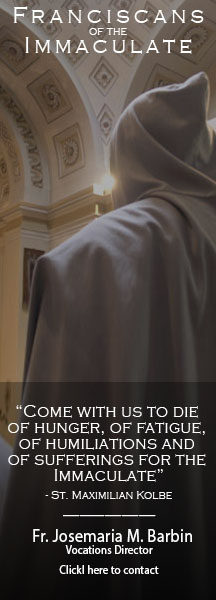Right thinking on matters of the Faith—orthodoxy— leads us to right practice—orthopraxis—and through right practice taking form in solidly Catholic spirituality and moral action, we learn to walk in the perfection of Christian virtue and to become saints.[1] St. Maximilian understood the necessity of both parts of the equation, the speculative and the operative, and found the way to ensure them both by consecrating himself to the Immaculate. In the care of her to whom God himself entrusted his own Son, St. Maximilian rose to the greatest heights of spiritual wisdom and heroic virtue. By coming to understand the teaching of this great Saint, we too can put his good doctrine into practice and rise to holiness.
St. Maximilian taught that saints are in some ways like the great men of the world, but are motivated supernaturally by faith in God and love for him. In this way, they are able not only to see beyond adversity, but to embrace the Cross in a spirit of sacrificial love. St. Maximilian also showed that holiness is found only in Christ Jesus, Who both tells us and shows us what holiness is and how it is to be achieved. Jesus, in His sacrificial love and obedience shown so poignantly on the Cross, and so humbly in the Eucharist, is the Way, the Truth, and the Life (cf. Jn 14:6). He is holiness, and the way to achieve it. St. Maximilian says: It is a false and widely diffused idea that the saints were not like us. They were also subject to temptation, they fell and got up, they also felt overwhelmed with sadness, weakened and paralyzed by discouragement. But remember the words of the Savior: ‘Without me, you can do nothing’ (Jn 15:51), and those of St. Paul: ‘I can do all things in him who strengthens me’ (Phil 4:13). Not confiding in themselves, but, putting all their confidence in God after every humiliating fall, they repented sincerely, they purified their soul in the Sacrament of Penance, and then they went back to work with still greater fervor.
We are very much deceived if we think we cannot become a saint, or that we will be “lucky” if we even make it to Purgatory. The great men of the world overcome all kinds of obstacles in order to become rich or famous. Why do we not try harder to persevere, when that is precisely what Our Blessed Lord deserves? After all, He poured Himself out for us so that we might be holy. The saints were not supermen; they were sinners who persevered through hardship and adversity because they were humble and repentant and confident in God’s grace.
St. Maximilian was “a prophet for our times,” who knew the tremendous difficulties that we would have to face in order to remain virtuous. He was aware of St. Louis de Montfort’s prophecy that the saints of the latter days would be pitted against the unleashed power of Satan, and that these saints would be preserved through their special devotion to the Immaculate Virgin.
It is not only heresy and persecution of the Church that we need to overcome—it is more importantly our own weakness and hypocrisy by which we profess a faith that we don’t live with complete generosity and steadfastness. Only the Immaculate can help us overcome ourselves.
In the end, holiness is not merely a warm feeling of God’s presence or even the ecstatic experiences of the saints. St. Maximilian tells us that true holiness is found in obedience, and obedience is acquired through prayer, penance and perseverance. Only the Immaculate preserves us in this resolution.
By virtue of consecration to Mary, souls take her as their ideal. But she is not merely an idea. She is not only an icon of holiness. She is our Mother, who loves us and lives with us and cares for us. She forms in us the perfection of Jesus. As St. Maximilian says: “We are to be formed on the model of Jesus.”
“When the sculptor works with stone, he must be very careful, as the slightest move in the wrong direction might injure the perfection of his art. It is different with a form; here there is no fear, provided the form is good.” From this we can understand our role—we are the substance that must take a form according the artist’s inspiration.
In the mystery of the Incarnation, the perfection of Son and Mother are inseparable. The analogy of artist and model becomes supercharged and dynamic as the one perfects the other. The one who forms Jesus’ humanity is herself an ideal form, because she is modeled after the Divine Model. As is the case with every mystery, there is a part we can grasp and a part that remains beyond reach.
What is clear, however, is that we sinners, called to be saints, need both a model of perfection to which to aspire and assistance in conforming to it. “Such an ideal form of perfection itself is the Mother of God, as the saints tell us. Therefore, let us be guided by her and allow her to form in us Jesus. That is a certain, assured and highly perfect way.”
St. Maximilian, the Saint who wrote about saints and sanctity, grew from a sinner who stumbled, to a hero of the faith, because he persevered in his
intention to live in unlimited consecration to the Immaculate. He turned to her in every difficulty and he humbled himself. He knew the hardships and dangers of the modern world and he overcame them, because he placed no limits on his willingness to surrender to God through the Immaculate.
We too can learn the wisdom of this great Saint by meditating on his teachings about sanctity. More effectively, by living it we can become saints. He professed that the quickest, surest, and sweetest way to sanctity is accessed through consecration to the Immaculate, who forms every saint in the likeness of her Son, the divine model of holiness. This is the great secret of St. Maximilian, who never tired of recommending all—be they hardened sinners or his religious confreres— to the “All Holy”, who was the substance of his thought and action: “He alone will spend his life well who constantly turns to the Immaculata. In her alone is the pledge of our perseverance and sanctification.” If we follow his advice and example, we may rest assured that she will obtain for us every grace we need in order to be conformed to her Son, Who is in Himself the very definition of sanctity.
Footnotes
[1] – Cf. Manelli, Stefano M. “Duns Scotus, the Scotistic Tradition and St. Maximilian M. Kolbe: The Foundations of Franciscan Marian Devotion and
Consecration to the Immaculate.” International Centenary Symposium on the Mariology of Blessed John Duns Scotus. Grey College, University of
Durham. Durham, England. 9 Sept. 2008.

